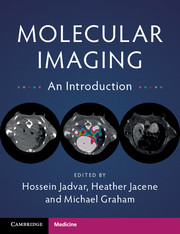Book contents
- Frontmatter
- Contents
- List of Contributors
- Preface
- 1 Instrumentation – CT
- 2 MRI/ MRS Instrumentation and Physics
- 3 Optical and Ultrasound Imaging
- 4 Instrumentation-Nuclear Medicine and PET
- 5 Quantitation-Nuclear Medicine
- 6 Perfusion
- 7 Metabolism
- 8 Cellular Proliferation
- 9 Hypoxia
- 10 Receptor Imaging
- 11 Apoptosis
- 12 Angiogenesis
- 13 Reporter Genes
- 14 Stem Cell Tracking
- 15 Amyloid Imaging
- Index
- References
7 - Metabolism
Published online by Cambridge University Press: 22 November 2017
- Frontmatter
- Contents
- List of Contributors
- Preface
- 1 Instrumentation – CT
- 2 MRI/ MRS Instrumentation and Physics
- 3 Optical and Ultrasound Imaging
- 4 Instrumentation-Nuclear Medicine and PET
- 5 Quantitation-Nuclear Medicine
- 6 Perfusion
- 7 Metabolism
- 8 Cellular Proliferation
- 9 Hypoxia
- 10 Receptor Imaging
- 11 Apoptosis
- 12 Angiogenesis
- 13 Reporter Genes
- 14 Stem Cell Tracking
- 15 Amyloid Imaging
- Index
- References
Summary
Glucose
Glucose is a major source of energy in many organisms. Processing of glucose may involve aerobic or anaerobic respiration with the purpose of producing energy in the form of adenosine-5’-triphosphate (ATP), a recycled molecular currency for cellular transfer of energy. The first step in both aeorobic and anaeroobic glucose metabolism is phosphorylation by hexokinase forming glucose-6-phosphate. In humans, the two major routes for further processing of the glucose-6-phosphate are eventual formation and storage of glycogen in the liver as stored energy or propagation toward the citric acid cycle with eventual production of CO2 and water. In aerobic respiration a molecule of glucose produces a net of 32 ATP molecules while anaerobic glucose metabolism generates a net of only 2 ATP molecules.
Glucose has played a key role in molecular imaging with positron emission tomography (PET) since the time when an analog of glucose was radiolabeled with the positron emitter, fluorine-18 that substituted for the 2’ position in the glucose molecule. This glucose analog, 2-deoxy-2-(18F)fluoro-D-glucose, abbreviated as FDG, enabled the imaging evaluation of glucose metabolism in health and disease. FDG PET has now unequivocally revolutionized clinical practice for a number of applications, most notably in cancer.
It has long been known that most tumors are hypermetabolic, with increased glucose metabolism (Warburg effect). The underlying mechanism and reason for elevated glucose metabolism in cancers is multifactorial and may relate to tumor-related factors (e.g. type and histologic differentiation), biochemical and molecular alterations (e.g. hypoxia), and nontumor-related components (e.g. inflammation). It has been proposed that the relationship between tumor growth and glucose metabolism may be explained in terms of adaptation to hypoxia through upregulation of glucose transporters (GLUTs) and increased enzymatic activity of hexokinase, as one of the “hallmarks of cancer.”
Glucose is transported across the cell via a family of fourteen facilitative GLUTs that are cell-specific and affected by hormonal and environmental factors. A list of these facilitative GLUTs can be found at www.genenames.org/cgi-bin/hgnc_search.pl (N.B. the currently approved gene symbol is SLC2Ax). The enhanced tumor glucose metabolism is associated with overexpression of primarily hypoxia-responsive GLUT1 or GLUT3 proteins. Increased hexokinase type II (of the four types in mammalian tissue) enzymatic level and activity has also been implicated in many cancers.
- Type
- Chapter
- Information
- Molecular ImagingAn Introduction, pp. 32 - 35Publisher: Cambridge University PressPrint publication year: 2017



